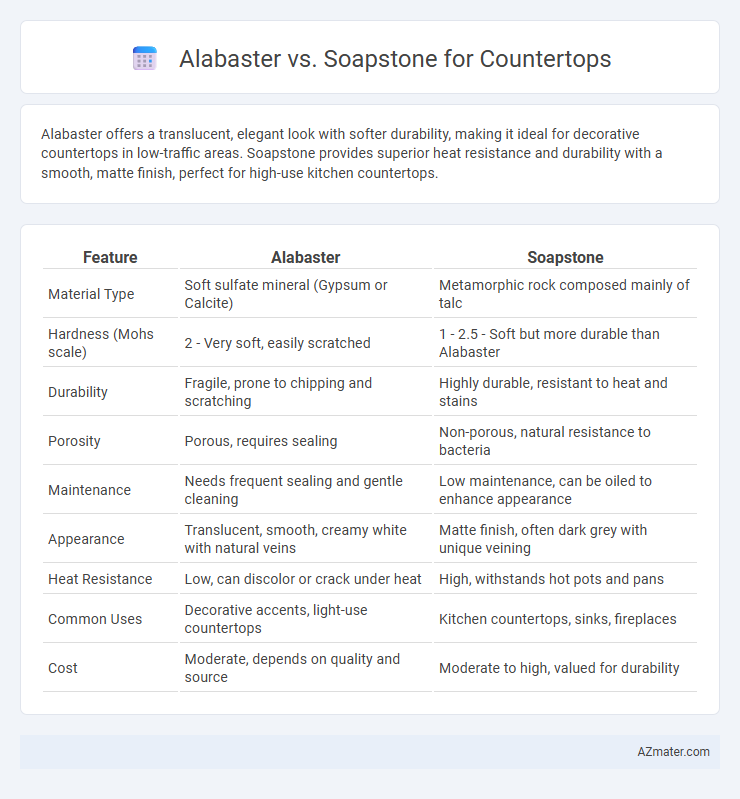Alabaster offers a translucent, elegant look with softer durability, making it ideal for decorative countertops in low-traffic areas. Soapstone provides superior heat resistance and durability with a smooth, matte finish, perfect for high-use kitchen countertops.
Table of Comparison
| Feature | Alabaster | Soapstone |
|---|---|---|
| Material Type | Soft sulfate mineral (Gypsum or Calcite) | Metamorphic rock composed mainly of talc |
| Hardness (Mohs scale) | 2 - Very soft, easily scratched | 1 - 2.5 - Soft but more durable than Alabaster |
| Durability | Fragile, prone to chipping and scratching | Highly durable, resistant to heat and stains |
| Porosity | Porous, requires sealing | Non-porous, natural resistance to bacteria |
| Maintenance | Needs frequent sealing and gentle cleaning | Low maintenance, can be oiled to enhance appearance |
| Appearance | Translucent, smooth, creamy white with natural veins | Matte finish, often dark grey with unique veining |
| Heat Resistance | Low, can discolor or crack under heat | High, withstands hot pots and pans |
| Common Uses | Decorative accents, light-use countertops | Kitchen countertops, sinks, fireplaces |
| Cost | Moderate, depends on quality and source | Moderate to high, valued for durability |
Introduction to Alabaster and Soapstone Countertops
Alabaster countertops, made from a translucent, soft stone primarily composed of gypsum, are prized for their warm, glowing appearance and delicate veining, making them ideal for decorative, low-traffic areas. Soapstone countertops, crafted from a dense metamorphic rock rich in talc, offer exceptional durability, heat resistance, and a smooth matte finish that ages gracefully with a natural patina. Both materials provide unique aesthetic qualities and functional benefits, with alabaster favoring elegance and softness, and soapstone emphasizing robustness and longevity.
Composition and Material Properties
Alabaster, primarily composed of gypsum, is a soft, translucent stone with a Mohs hardness of 1.5 to 2, making it more susceptible to scratches and etching compared to soapstone. Soapstone consists mainly of talc and magnesium silicate, resulting in a denser, non-porous surface with a Mohs hardness of 1 to 2.5, offering superior heat resistance and durability for countertop applications.
Aesthetic Differences: Color and Veining
Alabaster countertops showcase a translucent, milky white color with subtle, soft veining that creates an ethereal and elegant aesthetic. Soapstone offers a more muted, matte appearance with shades ranging from dark gray to black and features bold, flowing white or greenish veining that adds rustic character. The color contrast and veining patterns in alabaster provide a delicate, luminous look, while soapstone's stronger veining and deeper tones give countertops a robust, natural appeal.
Durability and Hardness Comparison
Alabaster countertops exhibit relatively low durability and hardness, ranking around 2 on the Mohs scale, making them prone to scratches and damage under heavy use compared to soapstone, which rates 1 to 3 but possesses a denser structure that enhances its resilience. Soapstone offers superior durability with its resistance to heat, staining, and impacts, maintaining integrity in high-traffic kitchen environments where alabaster surfaces often require more delicate handling and regular maintenance. The inherent softness of alabaster limits its functionality in countertops exposed to everyday wear, while soapstone's hardness and density provide a practical balance of aesthetic appeal and long-term performance.
Maintenance Requirements
Alabaster countertops require regular sealing due to their porous nature, making them vulnerable to stains and scratches, whereas soapstone is naturally non-porous and highly resistant to heat and stains, requiring minimal sealing. Soapstone develops a patina over time, which enhances its durability and reduces the need for intensive maintenance. Frequent oiling of soapstone can preserve its smooth texture and deepen the color, while alabaster demands more careful cleaning with mild, non-abrasive products to maintain its delicate surface.
Cost and Affordability
Alabaster countertops typically cost between $40 and $70 per square foot, making them a moderately priced option compared to other natural stones. Soapstone prices range from $70 to $120 per square foot, reflecting its higher durability and heat resistance. Budget-conscious homeowners often choose alabaster for its affordability, while those willing to invest more opt for soapstone due to its long-term value and low maintenance.
Heat and Stain Resistance
Alabaster countertops offer moderate heat resistance but are highly prone to staining due to their porous nature, requiring regular sealing to maintain appearance. Soapstone, composed primarily of talc, boasts excellent heat resistance and can withstand direct contact with hot pots and pans without damage. Soapstone's dense, non-porous structure also provides superior stain resistance, making it a practical choice for kitchen countertops exposed to spills and heat.
Environmental Impact and Sustainability
Alabaster countertops are less sustainable due to their delicate nature and higher likelihood of damage, leading to more frequent replacements and increased waste. Soapstone is more environmentally friendly, as it is durable, non-porous, and requires minimal maintenance, reducing the need for harsh chemical sealants or frequent repairs. Soapstone's natural resistance to staining and heat enhances its longevity, making it a preferred eco-conscious choice for sustainable kitchen surfaces.
Installation Process and Considerations
Alabaster countertops require careful sealing due to their porous nature, making installation more delicate and prone to staining if not properly protected. Soapstone is denser and non-porous, allowing for easier cutting and handling during installation, with minimal sealing needed since it resists stains and heat naturally. Both materials require experienced installers, but soapstone offers greater durability and lower maintenance concerns post-installation compared to alabaster.
Choosing the Right Stone for Your Countertop
Alabaster offers a soft, translucent appearance ideal for decorative accents but requires careful sealing and gentle use due to its softness, making it less suited for high-traffic countertops. Soapstone is a durable, non-porous material with excellent heat and stain resistance, favored for its smooth texture and low maintenance in kitchen environments. Selecting between alabaster and soapstone depends on balancing aesthetic preferences with practical needs for durability and upkeep in countertop applications.

Infographic: Alabaster vs Soapstone for Countertop
 azmater.com
azmater.com